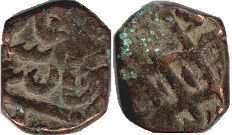Mughal Empire coins catalog with values
Mughal Empire
Mughal Empire, state in medieval India,
named after the Mughal dynasty that ruled there.
It was founded by Babur, the former emir of Ferghana and ruler
of Kabul, who in 1526 invaded the Delhi Sultanate, defeated the
troops of its ruler Ibrahim Shah of the Lodi dynasty at the
Battle of Panipat, occupied Delhi and declared himself sultan.
Before his death Babur divided the territory of his power,
occupying the areas of Eastern Afghanistan, Punjab (Panjab) and
the Ganges valley up to Bengal, among his sons. Humayun
inherited the Indian dominions proper from his father in 1530.
He conquered Malwa and Gujarat, but was defeated at Chausa
(1539) and Kanauja (1540) by the ruler of Bihar, Sher Shah of
the Sur family, and fled to Iran.
Having seized power, Sher-shah took steps to strengthen the
unity of the state and the position of the central authority,
carried out a census of lands, organized taxation. In connection
with the struggle for the throne that began after the death of
Sher Shah, Humayun captured Kabul in 1545 with the help of
Persian troops, and in 1555 defeated the army of one of Sher
Shah's successors, Sikandar Shah, and seized Delhi.
The Mogul Empire reached its greatest prosperity and
centralization during the reign of Akbar. After defeating his
strongest rival Hemu at the Battle of Panipat in 1556 and
establishing himself on the throne, Akbar reformed the system of
state administration by introducing the Mansabdari system of
rank. His viceroys began to receive allowances from the treasury
or jagirs (land holdings), on the income from which they were
obliged to maintain military detachments. He pursued a policy of
religious tolerance, which contributed to the consolidation of
the state. He strengthened ties with the Rajput principalities.
Under him, the Mogul Empire covered the territory from Balkh in
the north to the Godavari River in the south and from the
Arabian Sea in the west to the Bay of Bengal in the east and was
a centralized state, headed by the Padishah, who was also the
supreme owner of land.
In his hands was concentrated the full extent of legislative,
administrative, military and judicial power. The territory of
the Mughal Empire was divided into viceroyalties -
sub-districts, headed by subadars.
The dominant form of land tenure was jagir, zamindari and land
tenure of Muslim and Hindu clergy (wakf, soyurgal) were also
widespread.
Akbar's son Jahangir continued his father's conquest policy: he
defeated the ruler of Ahmadnagar (1616) and annexed Kangra to
the Mogul Empire (1620), but lost territories in Afghanistan
(including Kandahar). Shah Jahan's reign was marked by successes
against the rajas of the Deccan. In 1636 Ahmadnagar became part
of the Mughal Empire, and in 1638 the fortress of Kandahar was
returned. In 1646 Shah Jahan subjugated Balkh and Badakhshan,
but in the following years suffered a number of defeats from
Safavids and in 1647 lost Balkh, and in 1649 - Kandahar.
In 1658 Shah Jahan was overthrown by Aurangzeb, under whom the
Mogul Empire began to expand again. To cover military expenses
Aurangzeb increased taxes and resumed jizya. His policy of
religious intolerance caused a number of uprisings of non-Muslim
population of the Mughal Empire (Jats in Delhi and Agra, Sikhs
in Punjab, Satnami sect in Northern Rajputana).
The Maratha movement led by Shivaji, which led to the emergence
of the Maratha Confederation, finally undermined the power of
the Mughal Empire.
During this period, the influence of the British East India
Company increased significantly in the Mughal Empire, whose
strongholds were on the west coast in 1613-1616. Surat, from
1668 - Bombay (now Mumbai), on the east coast - from 1639 Madras
(now Chennai), in Bengal - from 1690 Calcutta (now Kolkata).
In the 2nd half of the 18th century the disintegration of the
Mogul Empire continued. Nominally recognized as the rulers of
the state, the Mughal padishahs actually ruled only small
territories adjacent to Delhi and Agra. Along with the
principalities headed by the Maratha dynasties of Bhosle
(Nagpur), Sindia or Shinde (Gwaliyar), Holkar (Indore), Gaekwad
(Baroda or Vadodara), Bengal, Aud, Rohilkhand, Deccan
(Principality of Hyderabad) were separated from the Mughal
Empire, and in the south the nawabstvo of Arkat (Karnatic) and
the Principality of Mysore emerged. Delhi was repeatedly
plundered by the troops of Persian Nadir Shah (1739) and Afghan
Ahmad Shah Durrani (in 1748, 1750, 1752, 1757).
In the mid-18th century, the British East India Company began
territorial seizures in the Mogul Empire. In 1757-1764 it
subjugated Bengal, by 1799 it conquered Mysore as a result of
the Anglo-Maratha wars, then as a result of the Anglo-Maratha
wars it conquered the Maratha principalities and obtained the
consent of the Padishah to administer the territories under his
authority on his behalf. The British East India Company annexed
Sindh in 1843, Punjab in 1849, then annexed the principalities
of Sambalpur (1849), Nagpur and Jhansi (1853), Hyderabad (1853),
and Aud (1856). In 1858, in accordance with the British Act for
the Better Government of India, the Mughal Empire was abolished
and power completely transferred to the British Crown.
Mughal Rupee
Muhammad Shah (1717-1748)

1 dam 17 (24-33)
copper
Value - 8-12 USD
Coins of Mughal Empire in the catalog are presented divided by historical periods, indicating the main characteristics and differences by type.
Inside the sections, the coins are sorted by denomination - from large to small.
The cost of the coin is approximate and is indicated specifically for the coin shown in the picture. You can use this price to evaluate similar coins (of the same type), but remember that the value is affected by many factors, such as the state of preservation and the date of minting. The cost of coins of the same type can vary greatly depending on the number of surviving copies.
Coins of Mughal Empire presented on this page are not sold or bought - this is only a catalog.
